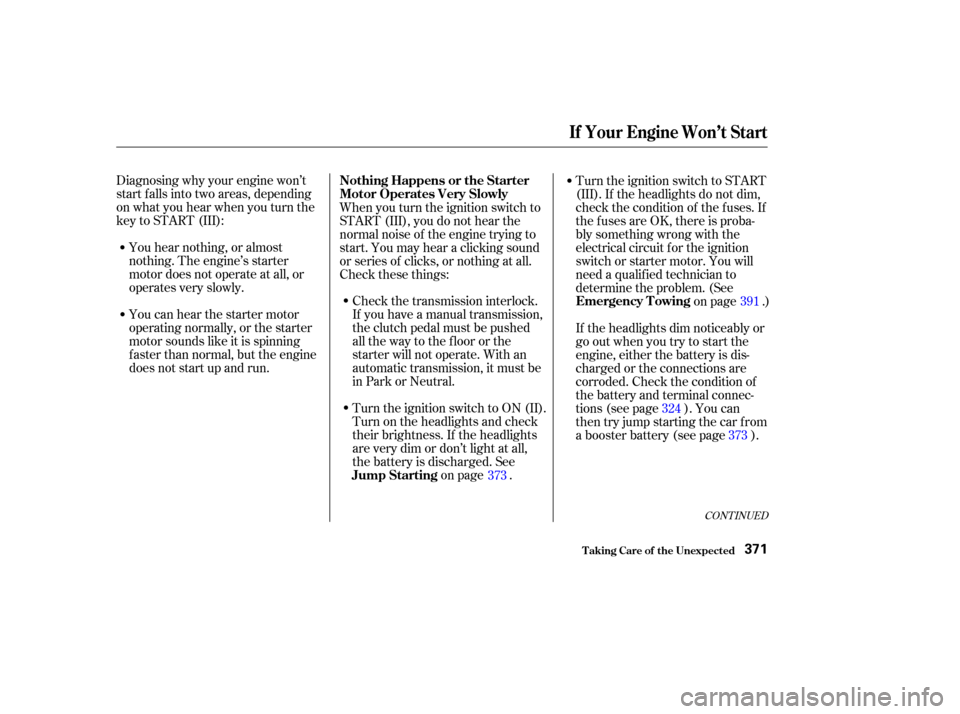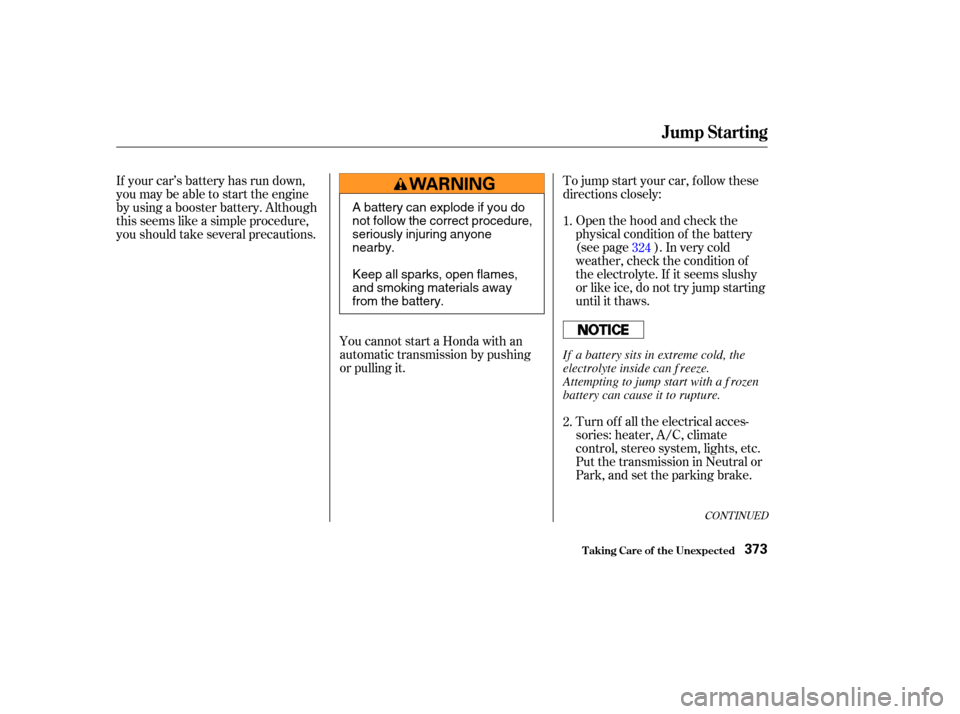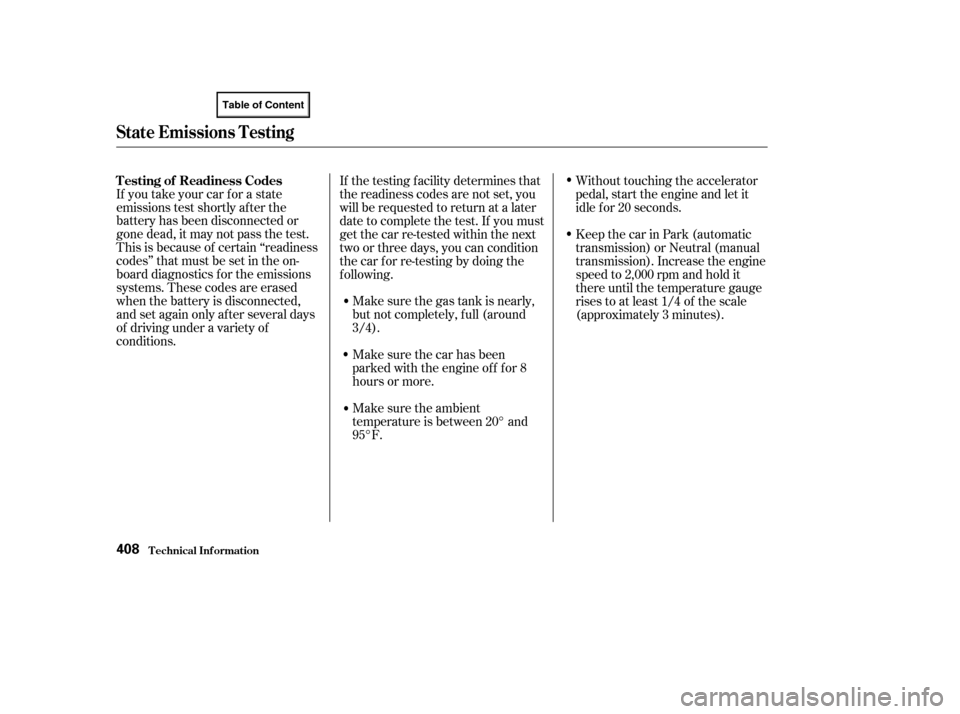Page 374 of 429

Diagnosing why your engine won’t
start f alls into two areas, depending
on what you hear when you turn the
key to START (III):You hear nothing, or almost
nothing. The engine’s starter
motor does not operate at all, or
operates very slowly.
You can hear the starter motor
operating normally, or the starter
motor sounds like it is spinning
f aster than normal, but the engine
does not start up and run. When you turn the ignition switch to
START (III), you do not hear the
normal noise of the engine trying to
start. You may hear a clicking sound
or series of clicks, or nothing at all.
Check these things:
Check the transmission interlock.
If you have a manual transmission,
the clutch pedal must be pushed
all the way to the f loor or the
starter will not operate. With an
automatic transmission, it must be
in Park or Neutral.
Turn the ignition switch to ON (II).
Turn on the headlights and check
their brightness. If the headlights
are very dim or don’t light at all,
the battery is discharged. See on page . Turn the ignition switch to START
(III). If the headlights do not dim,
check the condition of the f uses. If
the f uses are OK, there is proba-
bly something wrong with the
electrical circuit f or the ignition
switch or starter motor. You will
need a qualif ied technician to
determine the problem. (See
on page .)
If the headlights dim noticeably or
go out when you try to start the
engine, either the battery is dis-
charged or the connections are
corroded. Check the condition of
the battery and terminal connec-
tions (see page ). You can
then try jump starting the car from
a booster battery (see page ).
373 391
373
324
CONT INUED
Nothing Happens or the Starter
Motor Operates Very Slowly
Jump Starting Emergency T owing
If Your Engine Won’t Start
T aking Care of t he Unexpect ed371
Page 376 of 429

Put the transmission in Neutral or
Park, and set the parking brake. Open the hood and check the
physical condition of the battery
(see page ). In very cold
weather, check the condition of
the electrolyte. If it seems slushy
or like ice, do not try jump starting
until it thaws.
To jump start your car, f ollow these
directions closely:
If your car’s battery has run down,
you may be able to start the engine
by using a booster battery. Although
this seems like a simple procedure,
you should take several precautions.
You cannot start a Honda with an
automatic transmission by pushing
or pulling it. Turn of f all the electrical acces-
sories: heater, A/C, climate
control, stereo system, lights, etc.
1.
2.
324
CONT INUED
Jump Starting
T aking Care of t he Unexpect ed373
A battery can explode if you do
not follow the correct procedure,
seriously injuring anyone
nearby.
Keep all sparks, open flames,
and smoking materials away
from the battery.
If a battery sits in extreme cold, the
electrolyte inside can f reeze.
Attempting to jump start with a f rozen
battery can cause it to rupture.
Page 394 of 429

�µ�µ �µ
There are three popular types of
prof essional towing equipment. The operator
loads your car on the back of a truck.
The tow
truck uses two pivoting arms that go
under the tires (f ront or rear) and lif t
them of f the ground. The other two
tires remain on the ground. The tow
truck uses metal cables with hooks
on the ends. These hooks go around
parts of the f rame or suspension and
the cables lif t that end of the car of f
the ground. Your car’s suspension
and body can be seriously damaged.
If your Honda cannot be transported
by f lat-bed, it should be towed by
wheel-lif t equipment with the f ront
wheels of f the ground. If due to
damage, your car must be towed
with the f ront wheels on the ground,
do the f ollowing:
Release the parking brake.
Shif t the transmission to Neutral.
If your car needs to be towed, call a
prof essional towing service or, if you
belong to one, an organization that
provides roadside assistance. Never
tow your car behind another vehicle
with just a rope or chain. It is very
dangerous.
Release the parking brake.
Start the engine.
ShifttoD,thentoN.
Turn of f the engine.
With the f ront wheels on the ground,
it is best to tow the car no farther
than 50 miles (80 km), and keep the
speedbelow35mph(55km/h).
If your car is equipped with a f ront
spoiler, remove it bef ore towing so it
is not damaged.
Manual Transmission: Automatic Transmission:
CONT INUED
Flat -bed Equipment
Wheel-lif t Equipment Sling-t ype Equipment
This is the best way to transport
your Honda.
T his is
an acceptable way to tow your
Honda. T his method of towing is
unacceptable.
Emergency T owing
T aking Care of t he Unexpect ed391
Improper towing preparation will
damage the transmission. Follow the
above procedure exactly. If you cannot
shif t the transmission or start the
engine (automatic transmission), your
car must be transported with the f ront
wheels of f the ground.
Page 398 of 429
The Transmission Number is on a
label on top of the transmission. The Engine Number is stamped into
the engine block. It is on the f ront.
Identif ication Numbers
T echnical Inf ormation395
AUTOMATIC/MANUAL TRANSMISSION NUMBERENGINE NUMBER
6-cylinder Models MANUAL
TRANSMISSION
NUMBERENGINE NUMBER
4-cylinder Models
AUTOMATIC TRANSMISSION NUMBER
Page 399 of 429

�µ�µ�Î
�Î
�Î
�Î
T echnical Inf ormation
Specif ications (4-cylinder Models)
396
Dimensions
Weights
Air Conditioning Capacities
187.6 in (4,766 mm)
71.3 in (1,810 mm)
55.7 in (1,415 mm)
105.1 in (2,670 mm)
61.1 in (1,553 mm)
61.2 in (1,554 mm)
1.88 US gal (7.1
)
1.90 US gal (7.2)
1.37 US gal (5.2
)
1.40 US gal (5.3)
5.6 US qt (5.3
)
HFC-134a (R-134a)
17.6 19.4 oz (500 550 g) 4.4 US qt (4.2
)
4.2 US qt (4.0
)
ND-OIL8 2.0 US qt (1.9
)
2.2 US qt (2.1)
3.0 US qt (2.8)
6.9 US qt (6.5)
2.6 US qt (2.5
)
Including the coolant in the reserve tank and that remaining in the
engine.
Reserve tank capacity:
0.16 US gal (0.6
)
Excluding the oil remaining in the engine. 4.8 US qt (4.5
)
Length
Width
Height
Wheelbase
Track
Gross vehicle weight rating
Refrigerant type
Charge quantity
Lubricant type
See the certification label attached
to the driver’s doorjamb. Fuel tank
Engine
coolant
Engine oil
Manual trans-
mission fluid
Automatic
transmission
fluid
Windshield
washer
reservoir17.09 US gal (64.7
)
Front
Rear Approx.
1:
2: Change
Manual
Automatic
Total Manual
Automatic
Change Including
filter
Without
filter
Total
Change
Total
Change
Total
U.S. Cars
Canada Cars1
2
Page 401 of 429

�µ�µ�Î
�Î
�Î
�Î
T echnical Inf ormation
Specif ications (6-cylinder Models)
398
Dimensions
Weights
Air Conditioning Capacities
Length
Width
Height
Wheelbase
Track
Gross vehicle weight rating
Refrigerant type
Charge quantity
Lubricant type See the certification label attached
to the driver’s doorjamb. Fuel tank
Engine
coolant
Engine oil
Manual
transmission
fluid
Automatic
transmission
fluid
Windshield
washer
reservoir
Including the coolant in the reserve tank and that remaining in the
engine.
Reserve tank capacity:
Excluding the oil remaining in the engine.
61.1 in (1,553 mm)
61.2 in (1,554 mm)
17.6 19.4 oz (500 550 g) HFC-134a (R-134a)
ND-OIL8
2.6 US qt (2.5
)
4.8 US qt (4.5)
7.6 US qt (7.2
)
3.1 US qt (2.9)
5.3 US qt (5.0
)
4.2 US qt (4.0
)
4.5 US qt (4.3
)
0.16 US gal (0.6
) 1.77 US gal (6.7
)
2.22 US gal (8.4
)
105.1 in (2,670 mm)
1.74 US gal (6.6
)
187.6 in (4,766 mm)
71.3 in (1,810 mm)
55.7 in (1,415 mm)
2.17 US gal (8.2
)
2.3 US qt (2.2
)
2.6 US qt (2.5)
17.09 US gal (64.7
)
Front
Rear Approx.
1:
2: Change
Manual
Automatic
Total Manual
Automatic
Change Including
filter
Without
filter
Total
Change
Total
Change
Total
U.S. Cars
Canada Cars1
2
Page 402 of 429

�µ
�Î
�Î
�µ
�µ
�µ
�µ
�µ
�µ
�µ
�µ
�µ
�µ
�µ
�µ
�µ
�µ
�µ
�Î
�Î
�Î
�Î
�Î
�Î
T echnical Inf ormation
Specif ications ( 6-cylinder Models)
399
Engine
Alignment
Lights
Battery
Fuses
Tires Type
BorexStroke
Displacement
Compression ratio
Spark plugs
Toe-in
Camber
CasterWater cooled 4-stroke
SOHC VTEC
6-cylinder gasoline engine
Headlights
Front turn signal/parking/side
marker lights
Rear turn signal lights
Back-up lights
License plate lights
Ceiling light
High-mount brake light
Trunk light
Door courtesy lights
Vanity mirror lights
Spotlights
Capacity
Interior
Under-hood Size
Pressure
12 V
12 V
12 V
12 V
12 V
12 V
12 V
12 V
12 V
12 V
12 V
12 V
12 V
12 V
12 V
63 W (HB3)
51 W (HB4)
24/2.2 CP
21 W
21/5 W
18 W
3CP
8W
21 W
5W
2CP
1.1 W
8W
52 AH/5 HR
65 AH/20 HR
3.39 x 3.39 in (86.0 x 86.0 mm)
183 cu-in (2,997 cm
)
10.0 : 1
0.00 in (0.0 mm)
0.08 in (2.0 mm) 0°1°
3°15’
P215/50R17 93V P205/60R16 91V
T135/90D15 100M
32 psi (220 kPa , 2.2 kgf/cm
)
T135/80R16 101M
See page 390or the fuse label
attached to the inside of the fuse
box lid.
See page 389or the fuse box
cover. 60 psi (420 kPa , 4.2 kgf/cm
)
29 psi (200 kPa , 2.0 kgf/cm)
30 psi (210 kPa , 2.1 kgf/cm)
See spark plug maintenance sec-
tion page 323 .
Front
Rear
Front
Rear
Front
High
Low
1:
2:LX-V6, EX-V6 with automatic transmission
EX-V6 with manual transmission Front/Rear
Spare
Front
Rear
Spare
Stop/taillight/side marker lights
1
2
1
2
1
2
Page 411 of 429

Make sure the gas tank is nearly,
but not completely, f ull (around
3/4).
Make sure the ambient
temperature is between 20° and
95°F.Without touching the accelerator
pedal, start the engine and let it
idle f or 20 seconds.
If you take your car for a state
emissions test shortly af ter the
battery has been disconnected or
gone dead, it may not pass the test.
This is because of certain ‘‘readiness
codes’’ that must be set in the on-
board diagnostics f or the emissions
systems. These codes are erased
when the battery is disconnected,
and set again only after several days
of driving under a variety of
conditions.
Make sure the car has been
parked with the engine of f f or 8
hours or more.Keep the car in Park (automatic
transmission) or Neutral (manual
transmission). Increase the engine
speed to 2,000 rpm and hold it
there until the temperature gauge
rises to at least 1/4 of the scale
(approximately 3 minutes).
If the testing f acility determines that
the readiness codes are not set, you
will be requested to return at a later
date to complete the test. If you must
get the car re-tested within the next
two or three days, you can condition
the car for re-testing by doing the
f ollowing.
T esting of Readiness Codes
T echnical Inf ormation
St at e Emissions T est ing
408